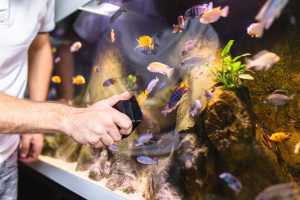
Reviving Old Ponds: A Guide to Restoration for Wildlife and Ecosystems
Reviving Old Ponds: A Guide to Restoration for Wildlife and Ecosystems
Understanding the Importance of Pond Restoration
Pond restoration, including the management of existing ponds, is crucial for nature recovery and biodiversity conservation.
Farmland ponds, including ghost ponds, are biodiversity hotspots and critically important for aquatic invertebrates, wetland plants, and protected species.
Restoring ponds can help maintain ecosystem services, such as pollution interception and water filtration.
Pond restoration can also support the recovery of natural vegetation and promote ecological connectivity in the farmed landscape.
Identifying and Assessing Ghost Ponds
Ghost ponds can be identified using historic maps, such as 1st edition Ordnance Survey maps, and comparing them with modern mapping.
Look for areas with natural vegetation, such as wetland plants, and signs of past water presence.
Assess the pond area and surrounding landscape to determine the potential for restoration and the need for additional conservation measures.
Consider the presence of protected species and the potential for the pond to fill naturally.
Planning and Executing Pond Restoration
Develop a restoration plan that takes into account the pond’s history, ecology, and surrounding landscape.
Clear trees and scrub, and perform sediment removal to restore the pond’s natural habitat.
Use local knowledge and expertise, such as the Pond Restoration Research Group and Freshwater Habitats Trust, to inform the restoration process.
Consider working with organizations, such as Norfolk Ponds and Norfolk Ponds Project, to access resources and expertise.
Restoration Techniques and Strategies
Restoring a pond requires a thoughtful and multi-faceted approach to ensure a thriving ecosystem. Here are some essential techniques and strategies to consider:
Assess the Pond’s Condition: Begin by evaluating the pond’s current state, including water quality, existing vegetation, and wildlife presence. This initial assessment will guide your restoration efforts.
Remove Invasive Species: Invasive species can disrupt the pond’s natural balance. Remove non-native plants and animals to protect the ecosystem and allow native species to flourish.
Restore Natural Vegetation: Reintroduce natural vegetation, such as pond plants, submerged plants, and deep water plants. These plants provide crucial habitat for wildlife and help improve water quality by filtering pollutants.
Improve Water Quality: Enhance water quality by reducing nutrient inputs from fertilizers and pesticides. Increasing oxygen levels through aeration can also support a healthier pond environment.
Create a Diverse Habitat: Incorporate various features like shallow water areas, deep water zones, and a mix of aquatic plants. This diversity supports a wide range of wildlife and promotes a balanced ecosystem.
Use Natural Materials: Opt for natural materials, such as wood and stone, to create a pond liner and surrounding habitat that blend seamlessly with the environment.
Monitor and Maintain: Regularly monitor the pond’s condition, including water quality and vegetation health. Ongoing maintenance is crucial to ensure the pond remains a vibrant and biodiverse habitat.
By implementing these strategies, you can create a restored pond that supports a rich variety of wildlife and contributes to the overall health of the ecosystem.
Community Involvement in Pond Restoration
Community involvement is a crucial aspect of pond restoration, as it not only raises awareness about the importance of ponds but also fosters a sense of ownership and responsibility among local residents. The Norfolk Ponds Project, for instance, has successfully engaged with local communities to restore over 250 ponds since its inception in 2014. By involving local people in the restoration process, projects like these can help promote nature recovery and protect biodiversity.
One way to encourage community involvement is to organize guided walks and workshops that educate participants about the importance of ponds and the restoration process. These events can be led by experts from organizations such as the Pond Restoration Research Group and the Freshwater Habitats Trust, who can provide valuable insights into the ecology and management of ponds.
Community members can also be encouraged to participate in citizen science projects, such as monitoring water quality, identifying aquatic invertebrates, and recording the presence of wetland plants. This not only helps to collect valuable data but also fosters a sense of ownership and responsibility among participants.
In addition, community involvement can help to promote the creation of new ponds and the restoration of existing ones. For example, local residents can be encouraged to create ponds in their own gardens or community spaces, which can help to increase the overall pond area and provide habitat for protected species.
To ensure the long-term success of pond restoration projects, it is essential to engage with local communities and promote a sense of ownership and responsibility. By working together, we can help to protect and restore our natural heritage, including the many ghost ponds that dot our farmed landscape.
In Norfolk, for example, the Norfolk Ponds Project has worked with local communities to restore many ghost ponds, which have been filled naturally with water and have begun to colonise naturally with aquatic plants and animals. These restored ponds not only provide habitat for protected species but also help to promote nature recovery and protect biodiversity.
Overall, community involvement is a vital component of pond restoration, and by working together, we can help to protect and restore our natural heritage for future generations.
Monitoring and Maintaining Restored Ponds with Natural Vegetation
Monitor the restored pond’s water quality, vegetation, including water plants, and wildlife populations to assess the success of the restoration.
Maintain the pond’s natural habitat by controlling invasive species and preventing pollution.
Allow the pond to colonise naturally, without introducing non-native species or artificial features.
Consider working with Natural England and other conservation organizations to ensure the long-term sustainability of the restored pond.
Case Studies and Examples
The Kent Downs Heritage Ponds project is a successful example of pond restoration and conservation in the farmed landscape.
The project has restored numerous ghost ponds, providing habitat for protected species and promoting biodiversity conservation.
Other case studies and examples of successful pond restoration projects can be found through the Pond Restoration Research Group and Freshwater Habitats Trust.
Overcoming Challenges and Finding Support
Common challenges in pond restoration include funding, landowner engagement, and technical expertise.
Seek support from organizations, such as the Pond Restoration Research Group and Freshwater Habitats Trust, to access resources and expertise.
Consider working with local communities and conservation groups to raise awareness and build support for pond restoration.
Look for funding opportunities, such as agri-environment schemes and grants, to support pond restoration projects.
Additional Resources
For more information on pond restoration, consider the following resources:
Pond Restoration Research Group: This research group is dedicated to studying and promoting effective pond restoration techniques. They offer valuable insights and guidance for restoring ponds.
Freshwater Habitats Trust: A charity focused on protecting and restoring freshwater habitats, including ponds. They provide resources and support for pond restoration projects.
Norfolk Ponds Project: A project aimed at restoring and creating ponds in Norfolk, UK. They offer practical advice and have successfully restored numerous ghost ponds.
Pond Plants: A comprehensive guide to selecting and caring for pond plants, including submerged plants, deep water plants, and water plants. This resource helps ensure your pond’s vegetation thrives.
Ghost Ponds: A guide to restoring and creating ghost ponds, with techniques for identifying and assessing potential sites. This resource is invaluable for bringing forgotten ponds back to life.
Existing Ponds: A guide to restoring and maintaining existing ponds, offering techniques for improving water quality and creating a diverse habitat.
Farm Ponds: A guide specifically for restoring and creating farm ponds. It includes techniques for enhancing water quality and supporting a variety of wildlife.
Pond Water: A resource focused on managing pond water, with techniques for improving water quality and reducing nutrient inputs.
Pond Surface: A guide to managing the pond surface, including creating a natural-looking pond liner and surrounding habitat.
Aquatic Invertebrates: A guide to managing aquatic invertebrates, with techniques for creating a diverse habitat and improving water quality.
By utilizing these resources and techniques, you can create a thriving and biodiverse pond that supports a variety of wildlife and enhances the surrounding ecosystem.
Conclusion and Future Directions
Pond restoration is a critical conservation strategy for maintaining biodiversity and ecosystem services in the farmed landscape.
By understanding the importance of pond restoration, identifying and assessing ghost ponds, and planning and executing restoration projects, landowners and conservationists can make a positive impact on the environment.
Future directions for pond restoration include scaling up efforts, improving technical expertise, and promoting policy and legislative support for conservation efforts.



